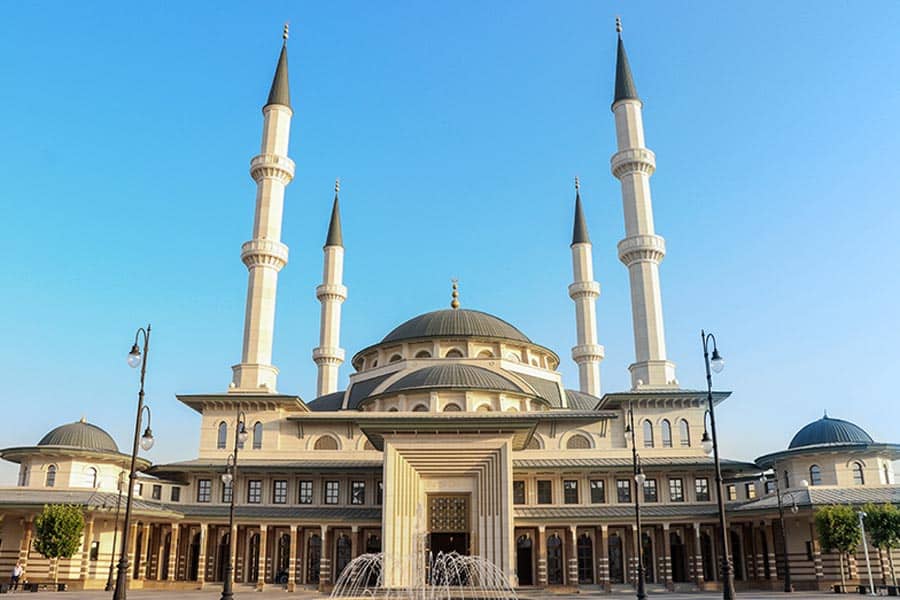A Numerous Award-Winning Underground Shrine: Sancaklar Mosque

Where it is: A little distant from the centre of İstanbul and one of the first places that comes to mind when it is said a modern mosque, Büyükçekmece Sancaklar Mosque resembles a simple cave from outside. Designed by the architect Emre Arolat, and also known as the “Underground Mosque”, the place makes its visitors feel like being underground due to its sloping land. Following such a way also has a spiritual meaning apart from architectural concerns: The people visiting here for performing prayers leave the outer world behind and integrate with the earth as they go down the stairs.
Interior space: The exterior of the Sancaklar Underground Mosque was built in harmony with the environmental texture, taking into account the importance that the religion of Islam attaches to the environment. The rips opened along the Qibla (the direction of Mecca) wall allow the sunray to be filter through inside. The materials used in interior design are far from exaggeration and show off, but rather modest and elegant.
Awards: Considered one of the best examples of modern mosque architecture, Sancaklar Mosque was deemed worthy of many prestigious awards, such as the “Best Religious Building of the Year Award” given for its extraordinary design by the World Architecture Association (WAC).
One of the New Symbols of İstanbul: Grand Çamlıca Mosque

Grand Çamlıca Mosque in Numbers: The 6 minarets of this magnificent building, which has recently taken its place in the İstanbul silhouette, represent the six pillars of faith. The mosque’s 4 minarets with 3 balconies are at an altitude of 107.1 metres as a tribute to the Victory of Malazgirt, and 2 minarets with 2 balconies of 90 metres. The main dome with an altitude of 72 metres symbolise the people from 72 nations living in İstanbul, and the other dome with a diameter of 34 metres symbolises İstanbul. In addition, on top of the main dome of the Çamlıca Mosque, there is the biggest alem in the world with a weight of 4.5 ton.
More than a sanctuary: The Grand Çamlıca Mosque, which is one of the biggest mosques in Türkiye and where 63 thousand people can perform prayers at the same time, also hosts a museum with a surface area of 11 thousand square metres, an art gallery of 3500 square metres and a library of 3000 square metres.
Beştepe People’s Mosque: A Modern Mosque Influenced by the Ottoman Architecture

Highlight: The fine handwritings carved on the walls of the mosque are selected from the Quranic verses involving the issues of state, justice, right and righteousness.
The Presidential Complex Beştepe People’s Mosque is one of the places for public access within the body of presidency of the republic. The foundation area is 5177 square metres and is covered with a main dome and four half-domes. In the mosque, comprising a basement floor, prayer floor and a gathering section, 3,000 people can perform prayer at the same time. Beştepe People’s Mosque also possesses the necessary arrangements for the disabled people can easily perform prayer.
Sanctuary of the Three Divine Religions: Doğramacızade Ali Paşa Mosque

Where it is: A modern mosque located at Ankara, Bilkent, Doğramacızade Ali Paşa Mosque is an active mosque since 2008. The architect of the structure is Erkut Şahinbaş.
Why it is important: Doğramacızade Ali Paşa Mosque is the first technological mosque of Türkiye, in which the smart building system is implemented. Just like in the Ottoman period, the mosque was designed as a cultural centre as well as a place of prayer. The two seminar halls in the structure can at the same time be used as a synagogue and a church; which means that the gates of Doğramacızade Ali Paşa Mosque is open to the believers of the three divine religions to the fullest.
Derinkuyu Park Mosque: The artwork of a sculptor

Rewind the date: The Sculptor Hakkı Atamulu, the designer of Derinkuyu Park Mosque in the city of Nevşehir, has an extraordinary story: Renowned for the sculptures of Atatürk that he has sculpted and considered as a world-class talent, after graduating from İstanbul Academy of Fine Arts in the first half of the 1900s, Atamulu goes to Germany and takes lectures from Garbo and Arnobrekker, the significant sculptors of the time. As the World War II outbreaks, the artist returns to Türkiye, to his birthplace Derinkuyu in the 1960s, and becomes the mayor of the district responding the insistence of the people. In 1989, Atamulu presents a sanctuary, the likes of which can rarely been seen, to the people. Derinkuyu Park Mosque takes its place as one of the sui generis examples of the modern mosque architecture in literature.
Ahmet Hamdi Akseki Mosque: A Mosque where there is no Chandelier inside

Where it is: Ahmet Hamdi Akseki Mosque in Ankara is the biggest mosque in Ankara. Inside the mosque, names of 40 Hadiths and 24 women Sahabah are written.
An interesting detail: Another distinctive sign of this glorious modern mosque is that there is no chandelier or lighting inside. In the mosque that is named after Ahmet Hamdi Akseki, one of the former directors of religious affairs, a special lighting and sound technology, all of which are concealed, were used.
Şakirin Mosque: A Touch of a Woman Architect

Why it is different: Üsküdar Şakirin Mosque is a wonder of modern architecture, with three sides covered with glass. Şakirin Mosque, the project design of which was made by the architect Hüseyin Tavla and the interior design by Zeynep Fadıllıoğlu, is at the same time the first mosque designed by a woman interior architect in our country. The pool in the inner court of the Şakirin Mosque is the artwork of the British water sculptor William Pye. The image of the mosque and minarets reflecting on this pool with a transparent dome invites its visitors to an imaginary, divine feast.

